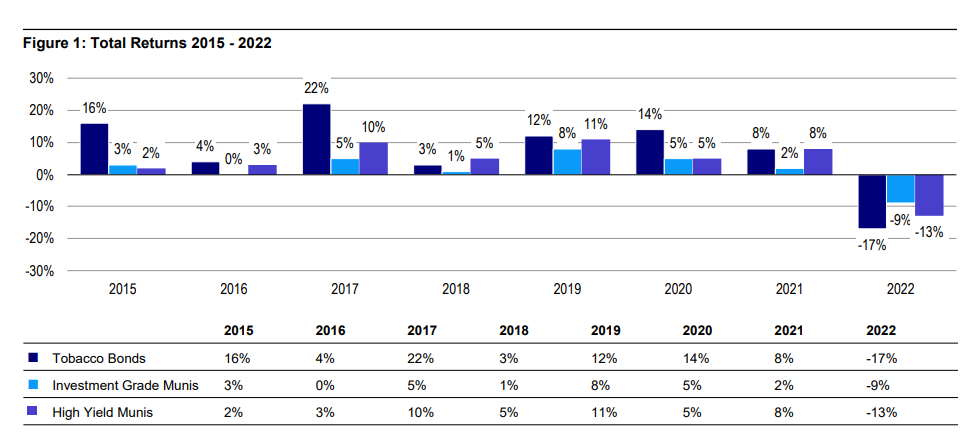But there is more than one type of bond in muni land and some may be lucrative for investors. In this case, it’s the tobacco settlement bonds.
With their natural inflation protection, high yields and tax-free status, tobacco bonds could make for an interesting portfolio addition for investors. And thanks to the growth of municipal bond ETFs and mutual funds, getting exposure is easier than ever.
The Tobacco Master Settlement Agreement
At the end of 1998, those lawsuits were settled, creating the Tobacco Master Settlement Agreement (MSA). Here, the major players would pay an initial $206 billion over 25 years in the MSA, which would be paid out to the states in the lawsuit. In addition, the attorney generals agreed to give up any future legal claims against the major players in return for annual payments to be made in perpetuity. Subsequently, a smaller smokeless MSA was also formed. Since the adoption of the MSA and facing additional lawsuits, approximately 41 more tobacco companies have joined the MSA, boosting its total value. Meanwhile, taxes were enacted on cigarettes and tobacco products boosting state revenues.
Tobacco bonds are a form of securitization. Several states did not want to wait or receive annual payments, so they created bonds backed by the cash flow they would receive from the MSA. Thus, tobacco bonds or tobacco settlement bonds were born.
Why Focus on Tobacco Bonds?
Because the MSA and perpetual payments are covered by cash flow from the underlying tobacco producers, there is a higher risk of default. With that, they are considered high-yield muni debt. But, because of the nature of the settlement, the MSA has its first crack at many of the producers’ assets. Meanwhile, bond holders have some interesting rights with regards to tobacco bonds. In the event of a default by the state, bondholders can receive payments directly from the producers/MSA themselves.
Secondly, tobacco bonds are inflation protected. The annual payment from tobacco companies is based on a formula, with consumption and inflation being the two main variables for annual payouts. As a result, rising prices have continued to boost the share of cash flow into the MSA and state’s coffers. Last year, payments rose by about 10% due to the surge in inflation, more than offsetting any declines in consumption.
These points have made tobacco bonds strong performers in terms of total returns versus other high yield and muni debt. This chart from Invesco sums up the segment’s wins over other muni categories.

Source: Invesco
Looking out further, the S&P Municipal Bond Tobacco Index, which tracks the bonds, is up nearly 77% on a total return basis over the last decade, which is really good for the sleepy municipal bond sector.
Getting Exposure to Tobacco Bonds
A better way could be broader exposure. As we said, the category is the one of the largest in the high yield sector. So many funds in the category feature plenty of tobacco bonds. Top index funds, the SPDR Nuveen Bloomberg High Yield Municipal Bond ETF and VanEck High Yield Muni ETF have about 3% and 5.41% of their holdings in tobacco bonds, respectively.
However, given tobacco bonds’ unique characteristics and benefits, investors may want to overweight those figures. And that means getting active management. The Invesco High Yield Municipal A is a top-rated fund with four out of its top ten largest holdings are tobacco-focused. Another tobacco-heavier-than the-index choice could be the American Century High-Yield Muni.
Here are some funds featuring tobacco bonds
| Name | Ticker | Type | Actively Managed? | AUM | YTD Ret (%) | Expense |
| Invesco High Yield Municipal A | ACTHX | Mutual Fund | Yes | $9.11 billion | 4.6% | 1.07% |
| SPDR® Nuveen Bloomberg High Yield Municipal Bond ETF | HYMB | ETF | No | $1.9 billion | 1.5% | 0.35% |
| VanEck High Yield Muni ETF | HYD | ETF | No | $3.31 billion | 1.3% | 0.35% |
| American Century High-Yield Muni | ABHYX | Mutual Fund | Yes | $0.82 billion | -0.9% | 0.6% |

